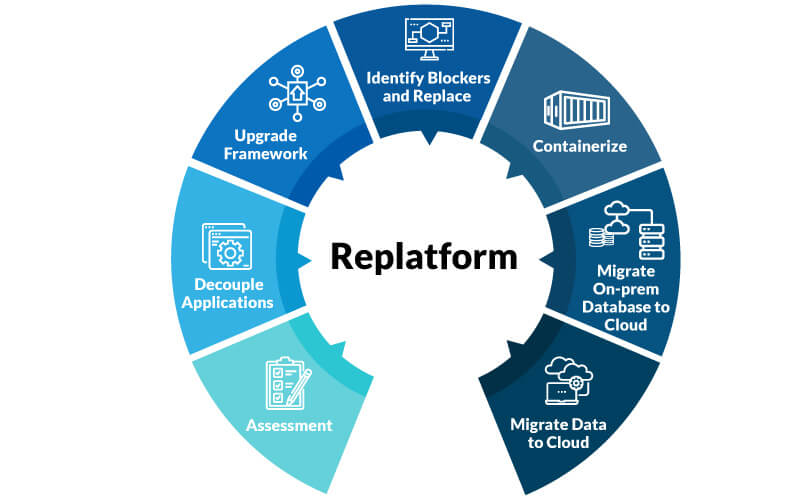Platform modernization refers to replatforming or rewriting of legacy application to a modern technology platform. A performance-oriented and cost-efficient strategy plays a highly critical role in successful application modernization. Rewriting, replatforming, and refactoring are the most reliable ways to avail maximum benefits from cloud migration. This blog mainly talks about the details, differences, advantages, and disadvantages of application cloud replatforming and rewriting.
Rebuild/Rewrite
Here, a legacy application is converted to a modern application where its dependent components are rebuilt, rewritten, or re-architected from scratch to avail complete feasibility provided by the modernized platform. It involves rewriting the entire application from scratch that can be deployed on cloud and can consume all the features provided by the cloud. Rewriting means rebuilding an existing application with latest technology stack and re-architecting the framework.
Few applications and its dependent components are specific to a framework that does not support cloud environment. Also, in some cases, the existing application resources may be more expensive and can cause higher cloud billing because due to large volume of data processing. In this case, it will not be feasible to choose replatform or refactor option for cloud migration. It would be good to rearchitect and rebuild the entire application for better cloud resource utilization and cost efficiency.
Key benefits of Rewriting
- Adds new features and improves performance of applications post cloud migration
- Takes full advantage of cloud ecosystems
- Creates service-oriented architecture from the scratch
- Applies latest cloud technologies
Disadvantage
- Time consuming and expensive process
- Functional knowledge of the existing legacy application is required to rebuild. It is more complex and time-consuming process if the application is developed several years back with very old legacy framework.
- Dependency of the application on other legacy applications needs to be verified before rewriting
- Knowledge upgradation needed to leverage latest technology
Replatforming
In application replatforming, a legacy application is converted to a more efficient and unified cloud application by enhancing system feature and re-organizing application without affecting its functionality to support and avail features of the cloud. Replatforming refers to application cloud migration with minimal code changes to consume maximum cloud benefits.
This approach is suitable when an organization is willing to avail cloud features without changing the core application architecture and business logic. This approach acts as a middle way between rehost and refactor.
Some of the common changes implemented during application replatforming:
- Expose service methods as micro/macro services
- Identify code blockers that does not support cloud and change/replace them with the ones that can avail cloud resources efficiently at minimum cost
- Convert the on-premise database to cloud database, if required
These changes will help to avail the common cloud components such as auto-dynamic loading, auto-scaling, etc. This strategy will overcome the major disadvantages of rewriting which is time-consuming and rehosting which does not avail all features of cloud.
Key benefits of application replatforming
- Cost and time efficient
- Cloud-native functionality like scalability, performance, etc.
Disadvantages of application replatforming
- If code changes do not add any value to an application in the cloud environment, then this strategy is not much useful
- This strategy focuses mainly on availing common cloud components with minimal code changes. So, the scope of changes should be well defined before starting code changes. If any specific or specialized components are required, then a dramatic code change may be required.
Amaze® – Hexaware’s proprietary automated application replatforming solution for mass cloud migration
Amaze® for Applications is a highly customizable application cloud replatforming product primarily designed for Java and C# applications. It enables application transformation to cloud seamlessly without any changes to your application’s existing business functionality. It can decisively review your existing workloads, perform code changes to remove and change code inhibitors for containerization, de-couple application, and then replatform your application servers and databases by utilizing maximum automation to save upon manual efforts. Below are the business benefits that Amaze® can deliver within 4-6 weeks along with scalability and future-ready flexibility while saving on excessive costs, maintenance time, and upgrades.
- Application TCO reduction by up to 75%
- Reduces transformation cost by up to 60%
- Reduces implementation time by up to 50%
The Figure 1 below depicts key steps in application cloud replatforming.

All these key steps can be achieved with Amaze® for Applications with very less timeline and cost. For more details on how Amaze® accomplishes these tasks, you can request a demo by writing to amaze@hexaware.com
How Amaze® performs the above steps for application cloud replatforming?
-
Assessment
The assessment engine in Amaze® helps to assess the legacy application and provides details about cloud readiness, replatform readiness, blockers, and the entire application inventory. This helps to perform preliminary analysis of the legacy application for estimation and possibility of replatforming without affecting its major functionality.
-
Decouples architecture
A monolithic application is a single tier software application in which the user interface and data access codes are combined into a single program from a single platform. Such monolithic application should be converted into service-oriented application by decoupling web layer and service layer. All the service methods should be converted into micro/macro services to modernize the application. This will make the application more suitable for cloud migration and modern framework.
Amaze® helps to assess the existing application and provides suggestions to expose service methods as micro/macro services. Its automation feature assist to decouple a monolithic application as web and service layer without disturbing its existing business logic.
-
Upgrades framework/components
Monolithic application might be created on older technology and may contain obsolete methods and dependent components. Amaze® highlights these obsolete methods and versions of framework and suggests equivalent, suitable methods and framework version. This is achieved by assessing the application in the preliminary stage.
-
Identifies blockers and replaces
Code assessment is critical to identify the blockers that do not support cloud remove or replace them with equivalent cloud supporting ones. Amaze® highlights such blockers during the assessment stage and replaces them automatically during application cloud replatforming.
-
Containerization
Migrated application and its dependent components should be bundled to execute independently. Containerization of existing code is an important step in replatforming. Amaze® takes care of containerization so that the application can run independently in any OS environment.
-
On-premise database to cloud database
Availing all the major features provided by cloud is an important aspect of application replatforming. Amaze® can easily migrate on-premise database with data to a cloud database. It can also replace traditional and costly on-premise database with a modern database platform (like PostgreSQL) to improve performance and reduce cost.
Conclusion
The main objective of application cloud replatforming or rewriting is cloud migration of on-premise database for costs savings, operational efficiencies, enhanced security, and auto-scaling. It involves various factors like choosing between rebuild or replatform strategy. Amaze® for Applications has automated option to replatform an application to the cloud. Its automation feature provides great benefits in terms of cost and time. So, start your cloud journey with a robust and futuristic strategy.



















